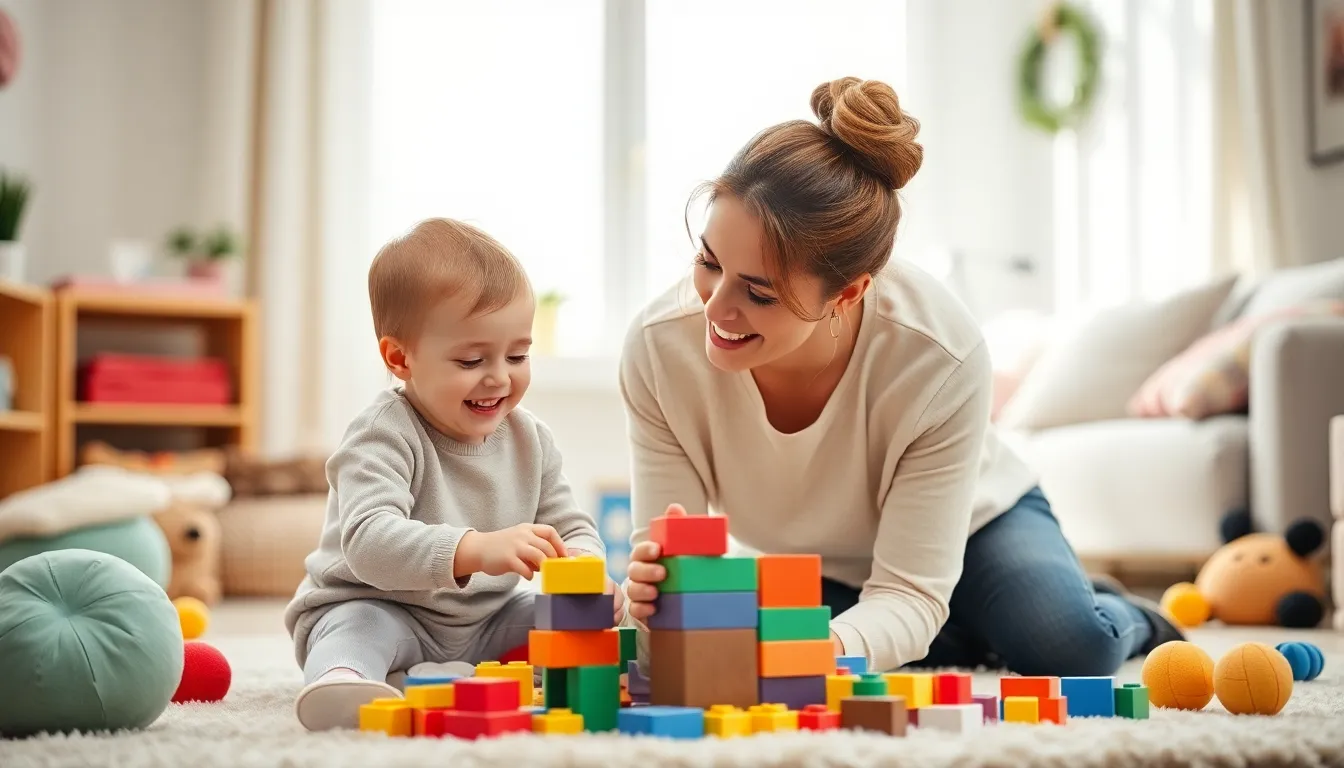Phone:
(701)814-6992
Physical address:
6296 Donnelly Plaza
Ratkeville, Bahamas.

Raising a toddler is like trying to train a tiny tornado—adorable yet unpredictable. One moment they’re giggling over a game of peek-a-boo, and the next, they’re staging a protest over broccoli. Every parent knows that navigating this whirlwind of emotions and energy requires more than just patience; it calls for a solid toolkit of parenting tips that can turn chaos into calm.
Understanding toddlers’ development helps parents navigate this challenging stage effectively. Parents need to recognize key growth phases that shape their child’s behavior.
Milestones serve as important indicators of development. By age one, many toddlers walk independently, showing improved mobility. Speech progresses rapidly; toddlers often say their first words between 10 to 14 months. Social skills emerge as they start to engage in parallel play, where they enjoy being around peers. At two years, verbal skills expand significantly, with toddlers typically using two- to three-word phrases. Exploring their environment leads to increased curiosity and independence, making this a crucial growth period.
Emotional changes frequently occur during toddlerhood. Toddlers may express a wide range of feelings, from joy to frustration, often without warning. They experience emotional outbursts, commonly known as tantrums, due to their limited ability to communicate needs. Sharing toys or waiting for a turn can also trigger strong reactions, reflecting their developing sense of self. Alongside these intense emotions, toddlers begin to show empathy, understanding how others feel. This mix of emotional growth challenges parents but also creates opportunities for connection and teaching emotional regulation.

Effective communication fosters understanding and connection with toddlers. Parents can implement strategies that enhance dialogue and emotional growth.
Listening to a toddler involves full attention and validation. Carving out time for conversations creates opportunities for meaningful exchanges. Responding to their utterances encourages toddlers to express themselves. Using open body language shows they are engaged in what their child shares. Mirroring their emotions reinforces understanding. When parents acknowledge feelings, it makes toddlers feel heard and respected. Taking cues from their body language and tone helps parents respond appropriately. Establishing consistent routines for discussion allows toddlers to know when to expect attention and interaction.
Encouraging expression nurtures language development and emotional awareness. Offering multiple ways for toddlers to communicate promotes diversity in expression. Introducing art or music as outlets allows toddlers to express feelings creatively. Asking open-ended questions invites toddlers to share thoughts and ideas, fostering critical thinking. Using descriptive language when discussing feelings expands their emotional vocabulary. Praising any attempts at communication builds confidence and encourages further expression. Allowing time for responses shows patience, reinforcing that their thoughts are valued. Celebrating small achievements in communication motivates toddlers to explore their expressive potential.
Establishing clear boundaries and consistent discipline strategies helps guide toddlers through their developmental challenges. Parents can use various techniques to foster positive behavior.
Positive reinforcement encourages toddlers to repeat desirable behaviors. For example, praising a child for sharing toys encourages them to continue doing so. Offering small rewards, such as stickers or extra playtime, can also motivate toddlers to engage in good behavior. Active reinforcement creates a nurturing environment where children feel supported. Further, using specific praise, such as “You did a great job helping clean up,” helps toddlers connect their actions with positive outcomes.
Time-outs serve as a useful discipline method when toddlers exhibit unwanted behavior. By temporarily removing a child from the current activity, parents create a space for reflection. The time-out should last for one minute per year of age; thus, a three-year-old would sit out for three minutes. This approach gives toddlers a structured break to calm down and understand the consequences of their actions. During the time-out, parents must remain calm and avoid engaging in discussions to prevent further escalation of emotions.
Promoting independence in toddlers fosters their confidence and self-reliance. Encouraging age-appropriate responsibilities cultivates essential skills.
Providing choices empowers toddlers and enhances their decision-making abilities. Examples include letting them pick between two outfits or choosing a snack from healthy options. Doing so instills a sense of control over their environment. Allowing autonomy within boundaries encourages exploration and further development. Toddlers flourish when they feel their preferences matter, leading to more cooperative behavior during daily routines.
Promoting self-help skills is crucial in building independence. Encourage toddlers to dress themselves with simple garments, like shirts with elastic necklines or pants with elastic waistbands. Offering opportunities to wash hands or brush teeth inspires responsibility for their hygiene. Additionally, involving them in mealtime, such as setting the table or choosing their food portions, enhances their confidence in contributing to family routines. By fostering these skills, parents equip toddlers to handle many tasks independently, paving the way for future self-sufficiency.
Creating a safe environment is crucial for toddlers. Parents must carefully plan their home to ensure safety and supervision.
Childproofing the home safeguards curious toddlers. Parents should cover electrical outlets to prevent shocks. Securing heavy furniture prevents tipping hazards. Keeping small objects out of reach stops choking risks. Installing safety gates at stairs limits access to dangerous areas. Store cleaning supplies and medications in locked cabinets. Using corner protectors minimizes injury from sharp edges. Maintaining a clutter-free environment allows toddlers to move safely. Opting for non-toxic materials supports a healthier living space. With these precautions in place, parents create a secure area for exploration.
Supervision plays a vital role in toddler safety. Consistent monitoring helps parents quickly respond to potential dangers. Children can get into trouble in just moments, so staying close is essential. Engaging with them during play encourages safe behavior and learning. Parents increase their awareness of toddler behavior through active observation. Setting up play areas within sight provides a safer space for exploration. Outings require vigilant supervision to avoid risky situations. Being present fosters a strong connection and enhances security. Through proper supervision, parents effectively reduce accidents and create a safer environment.
Navigating the toddler years can be a whirlwind of emotions and experiences. By implementing effective strategies parents can transform chaos into growth opportunities. Understanding developmental milestones and fostering communication are key to building a strong connection.
Setting boundaries and promoting independence not only guides toddlers but also boosts their confidence. Creating a safe environment ensures they can explore freely while minimizing risks. With patience and consistency parents can turn these challenging moments into cherished memories, paving the way for their child’s future success. Embracing this journey with love and understanding will ultimately make the toddler years rewarding for both parents and children.